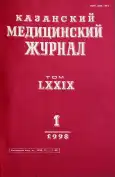Antithrombin III in shock and disseminated intravascular coagulation
- Authors: Vinazzer H.A.1
-
Affiliations:
- Blood coagulation laboratory
- Issue: Vol 79, No 1 (1998)
- Pages: 44-48
- Section: Articles
- URL: https://journals.rcsi.science/kazanmedj/article/view/63495
- DOI: https://doi.org/10.17816/kazmj63495
- ID: 63495
Cite item
Full Text
Abstract
Antithrombin III (AT III) is the physiological inhibitor of a series of activated clotting factors. Its diminution increases the tendency of thromboembolism. In cases of acute DIC, AT III binds to thrombin and to other activated factors in circulation. Thereby both partners of the reaction become inactive. When by this mechanism the available biologic activity of AT III diminishes below about 50% of normal any further inactivation of active clotting enzymes is greatly inhibited. In such cases, the mechanism of DIC decompensates and the full symptoms of consumption coagulopathy develop. It was, therefore, obvious to attempt a substitution with concentrates of AT III in such cases. In different randomized trials it could be shown which effect AT III concentrates had on the outcome of Die. In these tests it could be clearly shown that repeated administration of AT HI concentrates in a dose that keeps AT III activity constantly around 100% had the following advantages over therapy with heparin. The duration of symptoms of DIC could be considerably shortened from an average of 120 h in the heparin group to 40 h in the AT HI substitution group. Furthermore, in most severe cases of acute consumption coagulopathy due to septic shock, the death rate could be considerably and highly significantly diminished in the patients who received AT III. Similar results were also found by different authors who were able to demonstrate that the average survival rate in patients with septic shock increased from 20% to over 70% when AT III was substituted. Key Words: Antithrombin III—Heparin—Diffuse intravascular coagulation.
Keywords
Full Text
##article.viewOnOriginalSite##About the authors
H. A. Vinazzer
Blood coagulation laboratory
Author for correspondence.
Email: info@eco-vector.com
Austria, Linz
References
Supplementary files











